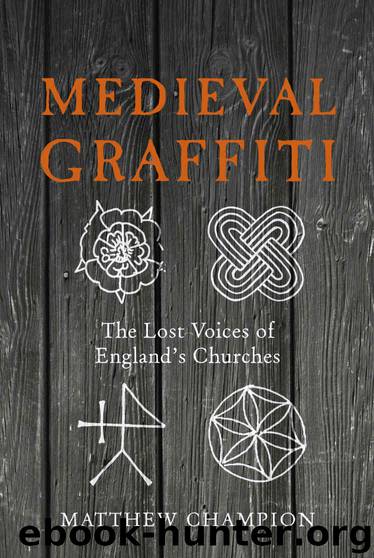Medieval Graffiti: The Lost Voices of England's Churches by Champion Matthew

Author:Champion, Matthew [Champion, Matthew]
Language: eng
Format: epub
ISBN: 9781473503632
Publisher: Ebury Publishing
Published: 2015-07-02T04:00:00+00:00
‘Might I but know thee by thy Household badge …’
William Shakespeare , Henry VI, Part 2
AMERCHANT’S MARK WAS a small symbol used by a merchant or trader in place of a signature. They are, in effect, early trademarks and not unlike the idea of a commercial logo today. They were used in a wide variety of ways, from marking a merchant’s goods and signing documents to being carved on their house or personal possessions. Although called ‘merchant’s marks’, they were not just confined to the use of traders and, for those below the level of nobility, appear to have been used in much the same way as a coat of arms was used by the upper classes. As a result, we see these marks carved into the tombs of the prosperous lower orders and even appearing on brass memorial tablets. According to F.A. Girling, who studied the subject back in the middle of the twentieth century, these marks could also be handed down from one generation to the next, just like a coat of arms, with perhaps only minor differences or amendments between generations. Girling also makes note of the case of Susan Parker of Ipswich. After the death of her husband, Augustine, in the late sixteenth century, Susan continued in business alone into the early years of the seventeenth century. Rather than creating her own merchant’s mark, she simply adopted the mark of her dead husband, differencing it slightly with the addition of the letter ‘S’.
Merchant’s marks are common finds in our medieval churches and cathedrals, and are often to be found clustered together in areas of the church. Although often mistaken for mason’s marks, these symbols are usually very distinctly different. Where mason’s marks tend to be made up of just straight lines, and are clearly created by a skilled individual, merchant’s marks tend to be more fluid and less well made. In addition, where mason’s marks are usually rather simple-looking, merchant’s marks can be a complex motif involving symbols and lettering – more complex ones appearing as complete monograms. Many of them include very recognisable forms, such as the letters ‘M’ or ‘V’, or the arabic numeral ‘4’.
The earliest recorded merchant’s marks appear to go back at least as far as the middle of the thirteenth century and, unsurprisingly, are to be found in the records of the great medieval trade centres of Norwich, London and Bristol. Given that tradesmen have been marking their goods long before that, and that these marks appear to be an extension of that practice, it is likely that there were many earlier examples that have been lost. Although they, like the mason’s marks, can upon occasion rather look like the runic inscriptions of the Anglo-Saxon period, there doesn’t appear to be any direct link between the two. In fact, many of the earlier merchant’s marks look rather less like runic inscriptions than some of the later ones. However, the practice has obviously been going on a very long time.
In medieval churches,
Download
This site does not store any files on its server. We only index and link to content provided by other sites. Please contact the content providers to delete copyright contents if any and email us, we'll remove relevant links or contents immediately.
The Secret History by Donna Tartt(18227)
Red Sparrow by Jason Matthews(5204)
Harry Potter 02 & The Chamber Of Secrets (Illustrated) by J.K. Rowling(3559)
In a Sunburned Country by Bill Bryson(3376)
Drawing Cutting Edge Anatomy by Christopher Hart(3301)
Figure Drawing for Artists by Steve Huston(3277)
Harry Potter and the Prisoner of Azkaban (Book 3) by J. K. Rowling(3125)
The Daily Stoic by Holiday Ryan & Hanselman Stephen(3116)
Japanese Design by Patricia J. Graham(3006)
The Roots of Romanticism (Second Edition) by Berlin Isaiah Hardy Henry Gray John(2825)
Make Comics Like the Pros by Greg Pak(2763)
Stacked Decks by The Rotenberg Collection(2699)
Harry Potter and the Deathly Hallows (7) by J.K. Rowling(2554)
Draw-A-Saurus by James Silvani(2514)
Tattoo Art by Doralba Picerno(2497)
On Photography by Susan Sontag(2494)
Foreign Devils on the Silk Road: The Search for the Lost Treasures of Central Asia by Peter Hopkirk(2389)
Churchill by Paul Johnson(2374)
The Daily Stoic by Ryan Holiday & Stephen Hanselman(2353)
